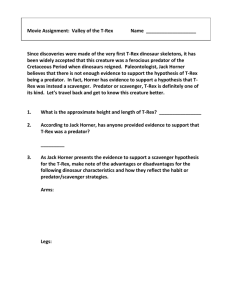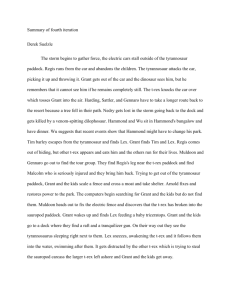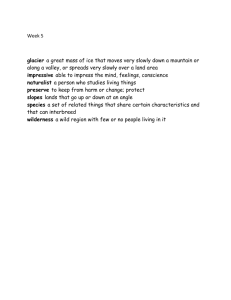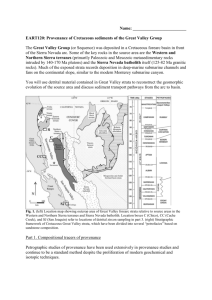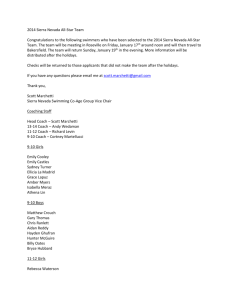Scientific justification for the Terrain
advertisement
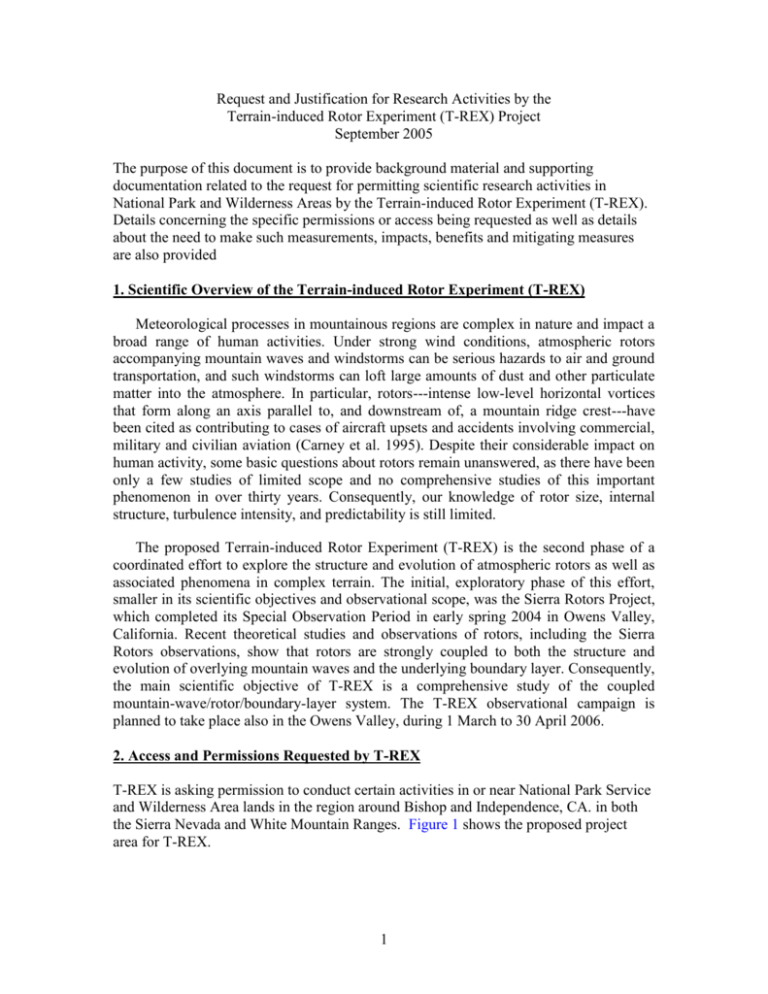
Request and Justification for Research Activities by the Terrain-induced Rotor Experiment (T-REX) Project September 2005 The purpose of this document is to provide background material and supporting documentation related to the request for permitting scientific research activities in National Park and Wilderness Areas by the Terrain-induced Rotor Experiment (T-REX). Details concerning the specific permissions or access being requested as well as details about the need to make such measurements, impacts, benefits and mitigating measures are also provided 1. Scientific Overview of the Terrain-induced Rotor Experiment (T-REX) Meteorological processes in mountainous regions are complex in nature and impact a broad range of human activities. Under strong wind conditions, atmospheric rotors accompanying mountain waves and windstorms can be serious hazards to air and ground transportation, and such windstorms can loft large amounts of dust and other particulate matter into the atmosphere. In particular, rotors---intense low-level horizontal vortices that form along an axis parallel to, and downstream of, a mountain ridge crest---have been cited as contributing to cases of aircraft upsets and accidents involving commercial, military and civilian aviation (Carney et al. 1995). Despite their considerable impact on human activity, some basic questions about rotors remain unanswered, as there have been only a few studies of limited scope and no comprehensive studies of this important phenomenon in over thirty years. Consequently, our knowledge of rotor size, internal structure, turbulence intensity, and predictability is still limited. The proposed Terrain-induced Rotor Experiment (T-REX) is the second phase of a coordinated effort to explore the structure and evolution of atmospheric rotors as well as associated phenomena in complex terrain. The initial, exploratory phase of this effort, smaller in its scientific objectives and observational scope, was the Sierra Rotors Project, which completed its Special Observation Period in early spring 2004 in Owens Valley, California. Recent theoretical studies and observations of rotors, including the Sierra Rotors observations, show that rotors are strongly coupled to both the structure and evolution of overlying mountain waves and the underlying boundary layer. Consequently, the main scientific objective of T-REX is a comprehensive study of the coupled mountain-wave/rotor/boundary-layer system. The T-REX observational campaign is planned to take place also in the Owens Valley, during 1 March to 30 April 2006. 2. Access and Permissions Requested by T-REX T-REX is asking permission to conduct certain activities in or near National Park Service and Wilderness Area lands in the region around Bishop and Independence, CA. in both the Sierra Nevada and White Mountain Ranges. Figure 1 shows the proposed project area for T-REX. 1 Yosemite National Park Ansel Adams Wilderness Area John Muir Wilderness Area Kaiser W.A. 10 nmi Death Valley National Park Muir W.A. Kings Canyon National Park Muir W.A. Monarch W.A. Figure 1. Proposed general project area for T-REX. Main focus of project activities is the Owens Valley and adjacent foothill regions of the Sierra Nevada and White Mountains. National Parks, Wilderness Areas, and the restricted Military Operations Areas (MOAs) are highlighted for reference. The project is requesting the following specific items: Access by project research aircraft to carry out occasional incursions into the restricted airspace at or below 3000 ft above ground level (AGL) over Wilderness Areas. These flights would only be done within prudent safety considerations and at least 1000 ft AGL. Make vertical measurements of atmospheric conditions including wind direction and speed, pressure, temperature and humidity using expendable packages released from aircraft over the National Park and Wilderness areas with the possibility that some small fraction of the expendable dropsonde units may land within the National Park or Wilderness boundaries. Request access to National Park Service and or Wilderness area data that may be useful to T-REX scientific analysis. A letter is attached to this request from Dr. Stephan Nelson of the U.S. National Science Foundation (NSF) indicating the strong level of support for this research effort. 2 3. Why does this work need to be done at this particular location? The Owens Valley, a narrow north-to-south oriented rift valley that lies in the lee of the southern Sierra Nevada (High Sierra), is a unique location for the rotor-coupled system study because several key elements important for the formation and documentation of rotors reach their extremes there. The first of those extremes is related to the height and shape of the terrain. Owens Valley lies between two very steep and tall mountain ranges. In particular, the southern part of the Sierra Nevada is the tallest, most linear mountain range in the contiguous United States with a compact ridgeline composed of a number of peaks exceeding 4,000 m ASL. The White-Inyo Range to the east is somewhat lower but still reaches close to 2,000 m above the valley floor (at 1,100 m MSL). Both the lee Sierra Nevada slopes and the windward Inyo slopes represent some of the steepest terrain in the lower 48 states with slopes reaching close to 30 degrees. These steep slopes, in particular, the lee slopes of the Sierra Nevada contribute to Owens Valley being a preferred site for generation of large-amplitude mountain waves, an important precursor of rotors. The second extreme element is related to the upstream environment. Except for fairly low Coastal Mountain Ranges of California, reaching only to some 300 m in their southern portion that lies to the west of the High Sierra, there is no other terrain upwind of the Sierra Nevada. Consequently, very little modification of air streams from the Pacific Ocean occurs before they reach the gentle upwind slopes of the Sierra Nevada. This is very important for mountain airflow studies as this allows us to unequivocally isolate the effect of the Sierra terrain on the perturbations downwind. The third extreme element of the Owens Valley environment is the dry Owens Lake bed located at the southern end of the valley. This dry lakebed is the largest single source of aerosol in the contiguous United States. During strong downslope wind and rotor events, dust storms commonly occur in the Owens Valley. While high concentrations of airborne aerosol during these dust storms represent a serious health hazard to Owens Valley inhabitants, it also increases performance of remote sensing lidar instruments, for which the strength of returns depends on the concentration of aerosol. Lidar measurements of the dust motion provide a unique opportunity to study the airflow and related entrainment and transport characteristics of these strong wind events. In addition the T-REX project will take advantage of special instrumentation already available in the region, e.g. LAWP. 4. What are the potential impacts of this research/operations on the wilderness? In order to achieve its scientific objectives, the T-REX program calls for a comprehensive observing system that consists of a number of ground-based and airborne, in situ and remote sensing measurement platforms to be deployed within as well as in the vicinity of Owens Valley. The airborne portion of the T-REX program involves three research aircraft equipped with a variety of onboard sensors and instrumentation to measure in-situ conditions along a flight path. Two of these aircraft are equipped with Global Positioning System GPS dropsonde deployment systems. A dropsonde is a meteorological instrument package launched from aircraft. It descends through the atmosphere by parachute and provides 3 detailed vertical structure of atmospheric winds, pressure, temperature and humidity. Information is relayed via telemetry link to the launch aircraft. The package is small (41 cm long, 7 cm diameter) and weighs less than 400 g. A picture of the package and detailed specifications are included in the attached Vaisala Dropsonde RD93 specification sheet. Planned flight tracks of these aircraft (See schematic in Figure 2) include ~300-km long cross-mountain flight tracks over the Sierra Nevada, Owens Valley, and the White-Inyo Range flown at a range of altitudes (from 15 to 46 kft) as well as mountain-parallel flight tracks on the lower upwind slopes of the Sierra Nevada flown at 15 to 46 kft. T-REX plans also call for the release of GPS dropsondes along these tracks in order to document the atmospheric properties in a deep layer of atmosphere over the study area. As these flight tracks pass over National Parks and Wilderness Areas, the airborne T-REX research operation could lead up to 50 dropsonde expendables landing in these areas. The only non-biodegradable part of a GPS dropsonde is a 6.7 cm by 27 cm circuit board containing electronic components and sensors. The parachute is made of nylon material (approximately 30 cm square) and is attached to the cardboard dropsonde cylinder by string. California ( ) indicate NWS sounding sites OAK, REV, VBG, EDW Nevada 300 km long flight track oriented 280°/100° true •Reno (REV) 250 km long flight track oriented 250°/070° true 70 km long flight track oriented along and centered over Owens Valley Oakland (OAK) • • Moffett Field NASA/AMES •Merced •Bishop •Fresno • Independence Nominal Sierra Nevada barrier orientation 320°/40° true (N of Bishop) 340°/60° (S of Bishop) • LeMoore • Edwards 0 50 100 km AFB (EDW) Vandenberg AFB (VBG) • Figure 2. T-REX Flight Plan Schematic (All aircraft). Location and orientation of track may vary somewhat based on cross-barrier wind direction and speed. The flight tracks in Figure 2 show the regions in which the research aircraft might propose to make limited passes in the restricted airspace over the National Park and 4 Wilderness areas (cf. Figure 1). The duration of any aircraft within this airspace will be quite limited. The aircraft crews have considerable experience in flying near terrain to study boundary layer conditions. Any of these flights will be done in a safe manner in appropriate visual flight rules (VFR) conditions no lower than 1000 ft AGL. Given the number of flight hours available to the aircraft, it is unlikely that more than 2 hours during each of 20 flights over a 60 day period would be in this airspace. The ground-based portion of the T-REX program is primarily Owens Valley based with some instrument installations in the San Joaquin Valley. The layout of the T-REX ground based network in the Owens Valley and nearby mountains is shown in Figure 3. While the majority of ground-based instruments have already been installed or are planned to be installed outside of wilderness areas, the T-REX plans call for a couple of surface towers to be installed within the John Muir Wilderness high up on the lee slopes of the Sierra Nevada. A separate proposal for the installation of these towers by the joint University of Leeds and Desert Research Institute groups (Burton et al.) has been filed with the U.S. Forest Service earlier this year. Figure 3. Layout of the T-REX ground based network in the Owens Valley and nearby mountains. 5 5. What are the potential benefits of this work for the wilderness and the management of the wilderness? The following benefits are expected: Improved forecasting/warning of severe surface weather in the higher elevations of the Sierra Nevada and in the Owens Valley area Improved forecasts/warnings to commercial, military, recreational, and search and rescue aviation operations, in, and near the higher elevations of the Sierra Nevada and the Owens Valley area Greatly improved scientific understanding of atmospheric processes in lee slopes of the Sierra Nevada, windward slopes of the White Mountains and Owens Valley including downslope windstorms, mountain waves and rotors. Better understanding of pollution episodes in Owens Valley and improved forecasting/monitoring of events where air quality is an issue. The research findings from T-REX will be applicable to other lee side locations worldwide where nearby mountains influence the weather to a large extent. Availability of a rich T-REX data archive fully open and accessible to researchers in this region and elsewhere. 6. How can we mitigate any negative impacts of this research on the National Park and Wilderness Areas? The occasional passage of low flying research aircraft will present a brief transitory disruption to ambient sound levels on the ground. Given the time of year, altitude of at least 1000 ft AGL, and general preference for flights over remote areas, no negative impacts are foreseen from this activity. We believe that the only possible negative impact is the occasional expendable package landing within the national park or wilderness area boundary. We propose to mitigate this situation by providing a one time monetary contribution to a Wilderness or Conservation group. These funds could be used to support any activities to find and remove expendables found near public access areas or trails. Or they could be used for any other suitable purpose to help administer this important national resource. 6 7 8

